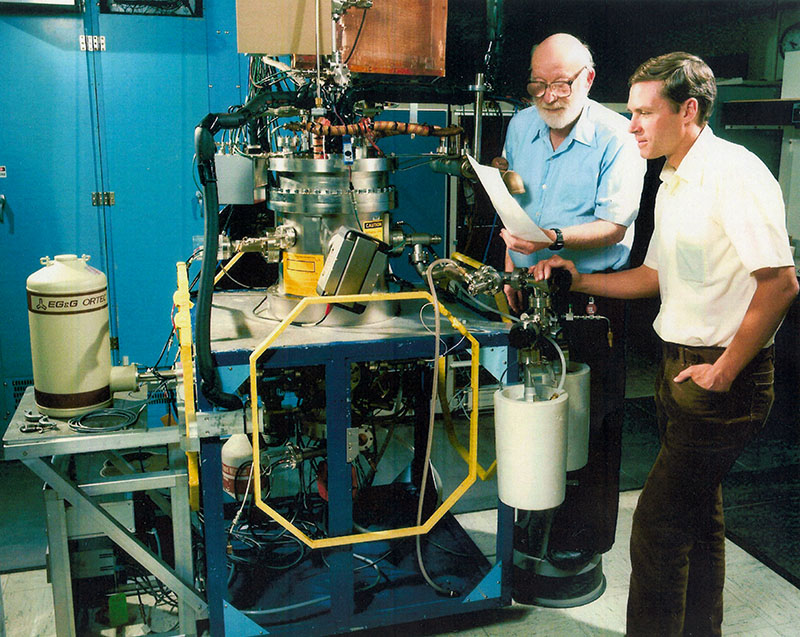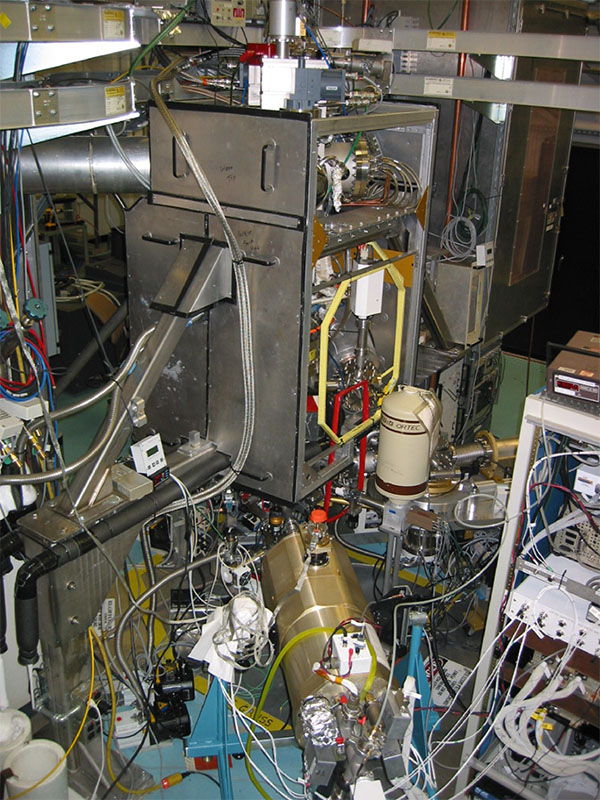Foundations: Laboratory x-ray astrophysics
For over 35 years, Lawrence Livermore researchers have created laboratory conditions that mimic those found in astrophysical objects to study the associated x-ray emission.
In the mid-1980s, an LLNL team invented and developed the first electron beam ion trap (EBIT-I) with the goal of measuring the atomic structure of highly charged ions. EBIT-I uses a magnetically compressed electron beam to ionize, trap, and excite ions. Information gathered by EBIT’s spectroscopic measurements helped precisely determine atomic and nuclear properties, including electron–ion interaction cross sections, initially providing the atomic data needed for fusion and x-ray laser research. With EBIT, researchers were able to obtain experimental data that confirmed or disproved theoretical predictions.
In the early 1990s, researchers harnessed EBIT-I for laboratory astrophysics, representing the first targeted use of an x-ray device for this purpose. EBIT-I makes astrophysically relevant ions from hydrogenic helium (He+) to hydrogenic nickel (Ni27+). It operates in the coronal density limit, with electron densities of about 5 x 1011 per cubic centimeter, making it perfectly suited for astrophysics investigations. These characteristics allowed EBIT to provide the atomic data needed for the spectral modeling of astrophysical observations.
To extend access to lanthanides and actinides, Livermore researchers built a high-energy version of EBIT-I, dubbed SuperEBIT, in the 1990s. With SuperEBIT, researchers can create and trap charge states as high as bare uranium (U92+). Researchers could now strip all the electrons from atoms of any naturally occurring element and therefore study any charge state of the corresponding ions.
Laboratory experiments to support x-ray observatories
The work to harness EBIT for laboratory astrophysics began in anticipation of the Chandra and XMM-Newton x-ray observatories, which both launched in 1999 and are still operational today. Chandra and XMM-Newton each carry a grating spectrometer with resolving powers between 100 and 1000 in the soft x-ray band, about a factor of ten higher than any previous observatories that study extrasolar sources. At these high resolving powers, much of the highly diagnostic and line-rich x-ray emission from L-shell ions of iron can be resolved. In addition, satellite and resonance lines from K-shell emission from hydrogen- and helium-like ions are also resolved, providing another set of robust plasma diagnostics.
Prior to the work at LLNL’s EBIT, large uncertainties were present in many of the atomic physics and spectral modeling packages that limited—and sometimes precluded—the use of the plasma diagnostics available from Chandra and XMM-Newton. Researchers used results from the EBIT measurements conducted throughout the 1990s to benchmark a variety of models and populate databases used to interpret spectra measured with Chandra and XMM-Newton.
Ushering a new era with x-ray microcalorimeter spectrometers
In 2000, scientists and engineers from NASA’s Goddard Space Flight Center (GSFC) provided the LLNL EBIT facility with its first microcalorimeter spectrometer, called the XRS, using spare components from the Astro-E space mission. A state-of-the-art instrument at the time, XRS made it possible to measure broadband spectra, covering approximately the 0.1 to 10 keV band, with a near constant energy resolution of better than 10 eV. In 2003, researchers made an upgrade to XRS that improved the capability to 6 eV resolution.
In 2008, the EBIT facility received a second-generation microcalorimeter spectrometer through continued collaboration with GSFC. Known as the EBIT Calorimeter Spectrometer (ECS), the instrument provides 5 eV energy resolution in the soft x-ray waveband (0.1–12 keV) and 30 eV resolution from 1 to 100 keV. The ECS cryogenic system has a much higher duty cycle, making experiments more efficient.
Spanning over two decades, both the XRS and ECS have acted as the workhorse instruments at the LLNL EBIT facility. The spectrometers dramatically improved the ability to monitor the conditions in the trap and made it possible to measure the spectral signature of charge-exchange reactions involving low-Z ions such as hydrogenic and helium-like oxygen and nitrogen. Researchers used these charge-exchange data to empirically fit the high-resolution spectra from comet Linear C/1999 S4 observed with Chandra. Incorporating the higher-energy bandpass of the ECS enabled absolute cross-section measurements on L-shell ions at higher beam energies for the first time, opening a new window to astrophysically relevant plasmas.
Enabling interpretation of spectra from the Hitomi mission
After the March 2016 launch of the Hitomi satellite, mission team members from LLNL played a leading role in understanding the groundbreaking observations of the galaxy cluster Perseus, answering long-standing questions about the role of turbulence in the most massive gravitationally bound objects in the universe. Measurements from LLNL’s EBIT-I enabled an accurate determination of the SXS’s energy scale and, together with high accuracy wavelength measurements using the Princeton Large Torus, made it possible to properly interpret the Perseus spectrum and helped uncover the source of discrepancies among leading spectral modeling codes.
Key dates
1986
EBIT measures its first x-ray spectrum from a highly charged ion
2000
XRS makes it possible to measure broadband spectra with a near-constant energy resolution of better than 10 eV
2003
Researchers determine the origin of the x-ray emission from comet Linear C
2016
LLNL team members play a leading role in understanding the groundbreaking observations of the galaxy cluster Perseus
Select publications
Publications related early work on EBIT and general atomic physics are available on the EBIT Publications page.
Hitomi Constraints on the 3.5 keV Line in the Perseus Galaxy Cluster | ApJL, 2017
Hitomi Collaboration
The quiescent intracluster medium in the core of the Perseus cluster | Nature, 2016
Hitomi Collaboration
Laboratory Measurements of the K-shell Transition Energies in L-shell Ions of Si and S | ApJ, 2016
N. Hell, G. V. Brown, J. Wilms, V. Grinberg, J. Clementson, D. Liedahl, F. S. Porter, R. L. Kelley, C. A. Kilbourne, P. Beiersdorfer
A brief overview of the Fusion and Astrophysics Data and Diagnostic Calibration Facility | Proc. SPIE, 2010
G. V. Brown, P. Beiersdorfer, J. Clementson, J. Dunn, R. L. Kelley, C. A. Kilbourne, M. Leutenegger, E. W. Magee, J. Park, F. S. Porter, M. Schneider, E. Trabert
Laboratory Simulation of Charge Exchange-Produced X-ray Emission from Comets | Science, 2003
P. Beiersdorfer, K.R. Boyce,G.V. Brown, H. Chen, S.M. Kahn, R.L. Kelley, M. May, R.E. Olson, F.S. Porter, C.K. Stahle, W.A. Tillotson
Laboratory X-Ray Astrophysics | Annual Review of Astronomy & Astrophysics, 2003
P. Beiersdorfer
Laboratory Measurements and Identification of the Fe XVIII-XXIV L-Shell X-ray Line Emission| ApJS, 2002
G. V. Brown, P. Beiersdorfer, D. A. Liedahl, K. Widmann, S. M. Kahn, E. J. Clothiaux
High-resolution measurements, line identification, and spectral modeling of K-alpha transitions in Fe XVIII-Fe XXV | ApJ, 1993
P. Beiersdorfer, T. Phillips, V. L. Jacobs, K. W. Hill, M. Bitter, S. von Goeler, S. M. Kahn
The Electron Beam Ion Trap: A New Instrument for Atomic Physics Measurements | Phys. Scr., 1988
M. A. Levine, R. E. Marrs, J. R. Henderson, D. A. Knapp, M. B. Schneider






